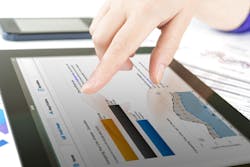As 2016 emerges and we look forward to the year ahead, it’s instructive to engage in a little prognostication. There are some clear trends that began to take hold in 2015 to inform our outlook on the coming year in water. Here are things to watch for in 2016, according to Jeff Lipton, director of marketing at WaterSmart.
Up, Up, Up
As the globe continues to recover from the economic chaos that began in late 2007, interest rates are slowly rising, increasing borrowing costs for needed infrastructure investments. Labor markets are tightening, making it difficult to find qualified workers at affordable rates in the face of a spate of utility retirements. Water costs are rising in many markets in the face of decaying infrastructure, strained supplies and depleted groundwater sources. Electricity costs for pumping and chemical treatment costs are not immune from these trends, and all these factors put pressure on utilities to raise rates for their users. Water rates increased 40% in America’s 30 largest cities between 2010 and 2015, and we can expect a similar, if not greater rate of increase across the board in 2016. In short, expect water rates to continue to rise for the foreseeable future.
Getting Smart
The march to implement advanced metering infrastructure (AMI) will surely continue as utilities face ongoing non-revenue water challenges, customer frustration and rising operational costs. The deployment of AMI allows utilities to reduce meter data collection costs and more easily identify apparent losses in their distribution systems. In addition, by offering end-users leak detection and real-time access to consumption data, customer engagement and satisfaction improves. This helps utilities gain the support they need for the rate restructuring needed to invest in infrastructure rehabilitation. While the water industry still trails electric utilities in smart meter adoption by an order of magnitude, expect the gap to narrow as the benefits of these solutions becomes clearer and the market moves past early adopters into the early majority phase.
Going Digital
Utilities will continue to implement modern SCADA, meter data management, customer information, billing and geographic information systems. With this growing set of data, sensible water utilities will be able to provide end-use customers access to consumption, billing and other utility program information through digital channels including Web, mobile, text, e-mail and integrated voice response. The utility of the future is rapidly emerging and looks very similar to the electric, mobile phone and financial service providers with which we regularly interact. Customers have come to expect real-time access to their information through the channel of their choice at the time of their own choosing, and the march toward digitization in the water industry will continue to follow these trends.
Storm Water & Water Reuse
The need for new supply sources has been apparent for some time, but ongoing urbanization and water stress due to climate variability is leading utilities to look for new, sustainable water sources. The implementation of programs and systems to collect and reuse storm water as well as deployment of modern water recycling technologies will see further emergence in 2016. The taboos associated with “toilet-to-tap” will begin to fade into the background as people learn more about the high-quality product that modern recycling solutions offer and utilities find few alternatives to address the need for additional sources. Desalination will remain on the table as an alternative water source, but the environmental challenges, time to implement and cost profile of this approach will be eclipsed by water reuse in commercial and industrial applications as grey water systems are recognized as increasingly cost effective in the face of rising water costs.
Proactive Customer Engagement
Customer expectations for data transparency and high-quality customer service are disrupting the legacy model of the silent service provider. With the parallel advent of AMI technologies, utilities now have the data tools and engagement channels that can help customers save water and money, protect their property and better manage natural resources for long-term environmental sustainability. This gives utilities a reason to engage their customer in communications that aren’t about rate increases, boil notices or system repair outages. The need to avoid customer interactions is now evolving into the opportunity to improve the customer relationship and build a partnership for broader community benefit.
None of these predictions are likely a surprise to anyone who has been tracking the water industry for any period of time, and the pace of change related to these items is likely to be (as is generally the case for water utilities) rather slow. Yet there are clearly underlying and irreversible shifts occurring in the industry to move toward addressing some of the more historically intractable problems we face, and everyone should celebrate this evolution, regardless of the speed. There is clearly no going back, and the sooner that we all embrace these trends, the sooner we arrive at the more sustainable and resilient future that we are all working to realize.
Source: WaterSmart


